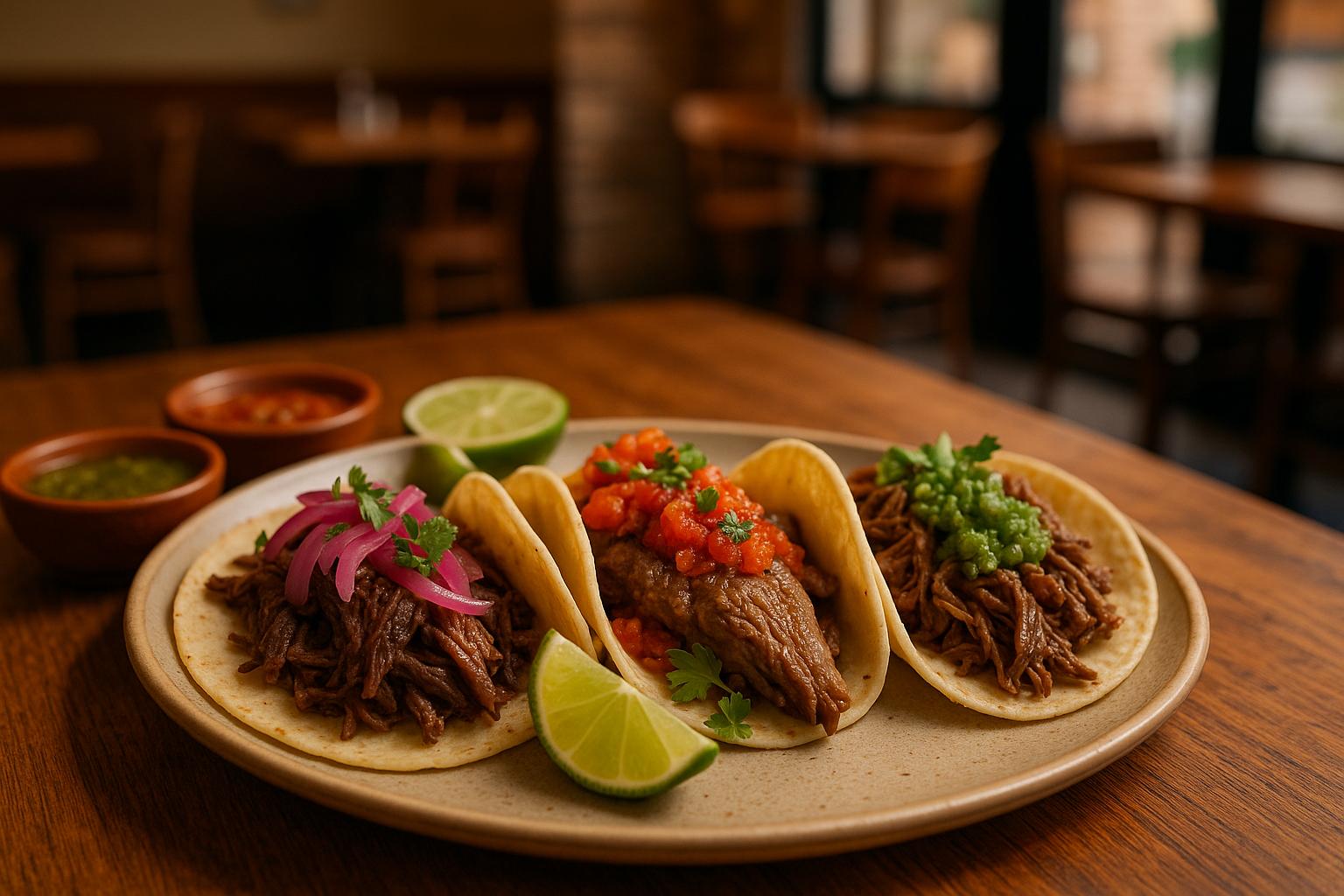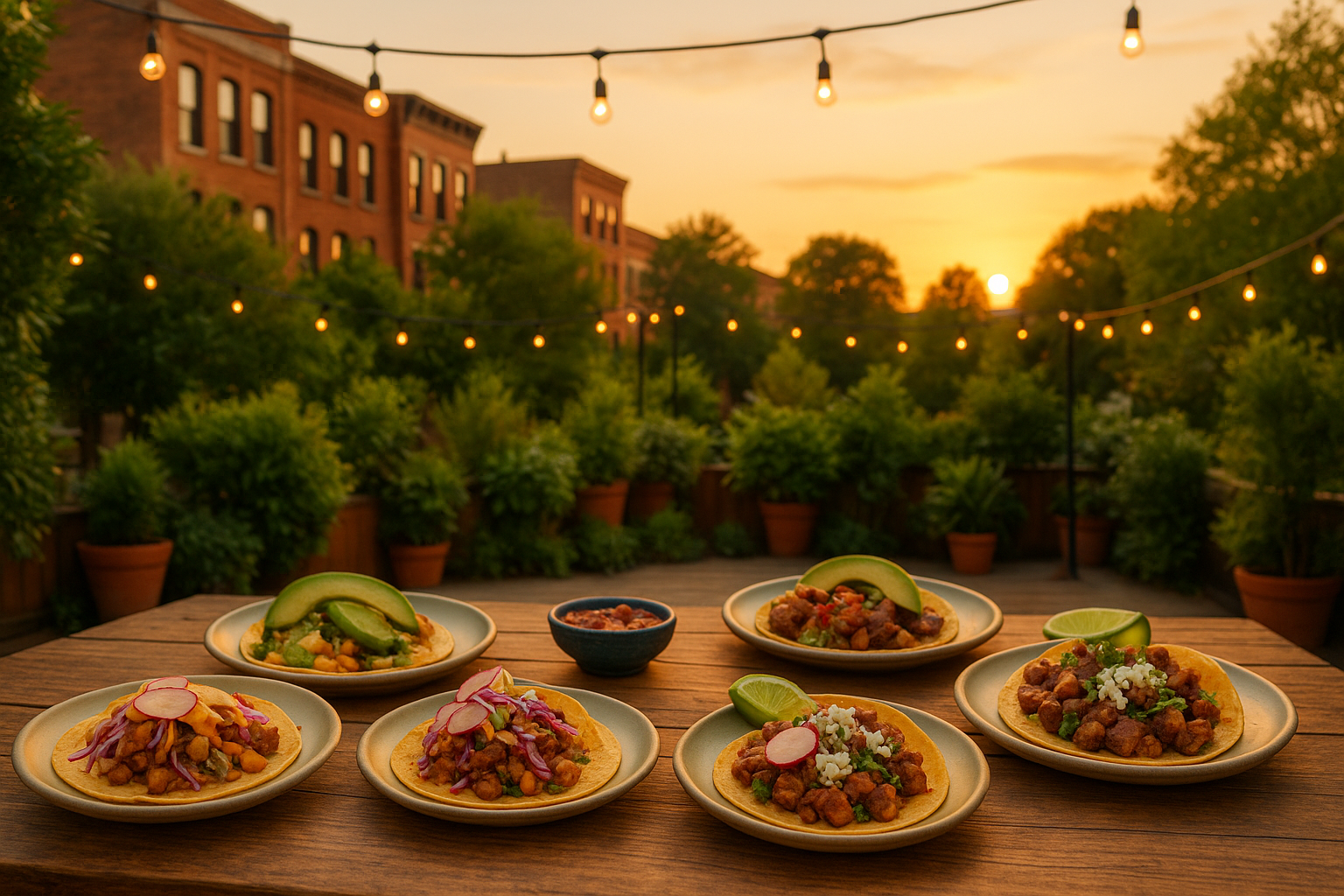Corn or flour tortillas? The choice depends on your taste, dietary needs, and the dish you're making. Corn tortillas are lower in calories, gluten-free, and packed with fiber and magnesium, making them a healthier option. Flour tortillas are higher in calories and fat but offer more iron and are perfect for dishes requiring a soft, pliable texture. Here's a quick comparison:
| Feature | Corn Tortilla (Large, 44g) | Flour Tortilla (Medium, 45g) |
|---|---|---|
| Calories | 95.9 | 138 |
| Carbs | 19.6g | 22.2g |
| Protein | 2.51g | 3.69g |
| Fat | 1.25g | 3.6g |
| Fiber | 2.77g | 1.58g |
| Iron | 0.54mg | 1.63mg |
| Magnesium | 31.7mg | 9.9mg |
Choose corn tortillas for authentic flavors, fewer calories, and better nutritional benefits. Opt for flour tortillas when you need flexibility for heavier fillings or Tex-Mex dishes. Both have their place in your kitchen - pick based on what your dish needs!
Whole Grain Corn Versus Refined Flour Tortillas (700 Calorie Meals, DiTuro Productions LLC)

History and Background
The story of corn and flour tortillas is deeply tied to distinct periods and traditions, each contributing to their unique characteristics. Their histories offer a glimpse into the cultural and culinary evolution of Mexico.
Corn Tortillas: Ancient Beginnings
Corn tortillas date back to prehistoric Mexico, with their origins linked to the domestication of corn in Mesoamerica around 10,000 B.C.E. [5]. For the Aztecs and Mayans, corn was more than just food - it was a vital part of daily life. They called these flatbreads "tlaxcalli" [7], a staple in their diet.
The name "tortilla", however, came later, introduced by the Spanish, meaning "little cake" [6][8]. Long before this term was coined, ancient Mesoamericans had already developed nixtamalization - a method of cooking corn in an alkaline solution. This process not only improved the dough's texture but also boosted its nutritional value [1], turning corn into a dietary cornerstone.
Even today, Mexico celebrates its incredible corn diversity, cultivating over 42 varieties of maize across the country [5]. As Chapala Mexican Restaurant aptly puts it:
Maize isn't merely a crop to Mexicans and people from Central America, it's a symbol of their culture. Tortillas are one of their most cherished foods and the foundation for many traditional Mexican dishes. [5]
While corn tortillas have ancient roots, flour tortillas emerged from a very different historical and cultural backdrop.
Flour Tortillas: A Colonial Influence
Flour tortillas tell the story of adaptation and change during the Spanish colonial period. Wheat, introduced by Spanish colonizers in the 16th century, became a key crop in New Spain. Catholic monks played a significant role in spreading wheat cultivation - by the 1530s, Franciscans brought wheat to Michoacán, and by the 1540s, Dominicans introduced it to Oaxaca [9]. The crop thrived in Mexico's temperate highlands, especially in areas between 4,000 and 9,000 feet above sea level [9].
Originally prominent in central and southern Mexico, wheat production expanded over time. By the late 19th century, regions like Jalisco, Zacatecas, Guanajuato, Chihuahua, Puebla, and the State of Mexico became major wheat producers. Central Mexico led the way until the 1930s, when northern Mexico took the lead [9].
Flour tortillas, or tortillas de harina, reflect the influence of European culinary traditions [1]. Though corn tortillas have long been the backbone of traditional Mexican cuisine, flour tortillas have established themselves as essential for dishes like burritos, quesadillas, and fajitas.
Together, these two types of tortillas - shaped by different histories and cultural influences - continue to coexist, enriching Mexico's culinary traditions with their distinct flavors and textures.
Nutrition Facts Comparison
When comparing the nutritional profiles of corn and flour tortillas, the differences become clear. These details can help you decide which option better suits your dietary needs.
Corn Tortillas: Fewer Calories and Gluten-Free
Corn tortillas stand out in several nutritional areas. A single large corn tortilla (44 grams) has about 95.9 calories, making it a lower-calorie choice compared to a medium flour tortilla [3]. This makes them a great option for anyone keeping an eye on their calorie intake.
Corn tortillas also shine when it comes to fiber content. A large corn tortilla contains 2.77 grams of fiber, which supports digestion and helps you feel full. Eating four small corn tortillas provides 24% of your daily fiber requirement [3] [11].
For those with gluten sensitivities or celiac disease, corn tortillas are a safe pick. As WebMD explains:
When it comes to nutrition, corn tortillas have the advantage of being made from whole grains, with fewer calories, sodium, and carbs but more fiber than flour tortillas. They're also gluten-free. [2]
Corn tortillas are also a good source of magnesium, with 31.7 mg per large tortilla. Consuming four small corn tortillas gives you 17% of the daily magnesium value, which is essential for muscle and nerve function [3] [11].
Flour Tortillas: Higher Calories but More Iron
Flour tortillas, on the other hand, pack more calories and fat. A medium flour tortilla (45 grams) contains 138 calories and 3.6 grams of fat, compared to corn tortillas' 1.25 grams of fat [3]. The higher fat content often comes from the lard or shortening used in the production process [3].
However, flour tortillas have an edge in iron content. A medium flour tortilla provides 1.63 mg of iron, significantly more than the 0.54 mg found in a corn tortilla [3]. Two large flour tortillas can supply 17% of your daily iron needs, while four small corn tortillas only cover 6% [11].
Additionally, many flour tortillas are fortified with extra nutrients, such as B-vitamins and additional iron, to make up for nutrients lost during the refining process [10]. This fortification can be beneficial for those looking to increase their intake of these nutrients.
Side-by-Side Nutrition Breakdown
To better understand the differences, here’s a direct comparison of the two:
| Nutrient | Corn Tortilla (Large, 44g) | Flour Tortilla (Medium, 45g) |
|---|---|---|
| Calories | 95.9 | 138 |
| Carbohydrates | 19.6g | 22.2g |
| Protein | 2.51g | 3.69g |
| Fat | 1.25g | 3.6g |
| Fiber | 2.77g | 1.58g |
| Iron | 0.54mg | 1.63mg |
| Magnesium | 31.7mg | 9.9mg |
The numbers highlight some key points: flour tortillas nearly double the calories and fat of corn tortillas, while corn tortillas deliver much more fiber and magnesium. As Lisa Wartenberg points out:
corn tortillas tend to outshine flour tortillas as the healthier option [3]
When looking at 100-gram servings, the gap widens even more. Corn tortillas contain 159 calories, while flour tortillas jump to 304 calories - almost double [2]. Sodium levels are also strikingly different, with flour tortillas containing 732 mg of sodium compared to corn tortillas' 136 mg per 100 grams [2].
sbb-itb-8621021
Flavor, Texture, and Best Uses
The difference in flavor and texture between corn and flour tortillas plays a big role in shaping your taco experience. Knowing these distinctions helps you pick the right tortilla for every dish.
Corn Tortillas: Bold Flavor and Firm Texture
Corn tortillas bring a unique, earthy flavor that's a cornerstone of authentic Mexican dishes. Food blogger Byron Talbott explains their appeal:
Corn tortillas reflect their process of being made from finely ground corn and then quickly pressed and cooked. [12]
This toasted, earthy taste pairs beautifully with traditional fillings like carnitas or al pastor, adding depth to every bite. However, their firm texture can be a double-edged sword. While it holds up well to juicy fillings, it’s prone to cracking if overstuffed, making it less ideal for dishes requiring a lot of folding.
One of their standout traits is their resistance to soaking up liquids. This means your taco fillings stay intact, and the tortilla maintains its structure and texture - a big win for dishes with juicy or saucy toppings [4].
Flour Tortillas: Soft Texture and Subtle Flavor
Flour tortillas, on the other hand, have a soft, pliable texture and a mild flavor. Byron Talbott describes their taste as:
They [flour tortillas] have a slightly sweet, but subtle flavor and are perfect if you don't want them overpowering any of the flavor components in the taco filling itself. [12]
This neutrality lets the fillings take center stage, making them a great choice for saucy or hearty ingredients [4]. Their soft and flexible nature is perfect for tacos loaded with breakfast ingredients, thick fajita strips, or generous portions of beans and rice. Unlike corn tortillas, they can handle the weight and moisture of heavy fillings without breaking apart.
Flour tortillas are also a favorite in Tex-Mex cuisine, where richer and saucier dishes dominate [14]. Their larger size and sturdy construction make them ideal for burritos, quesadillas, and other dishes that require wrapping or folding.
Mixed Options: The Best of Both Worlds
For those looking to combine the best traits of both, hybrid tortillas are a great solution. Wheat-enriched corn tortillas blend the bold flavor of corn with the flexibility of flour, making them a great match for heartier fillings [13]. They deliver the taste of corn while offering the pliability needed for folding or wrapping.
Another option is using smaller corn tortillas. Their compact size reduces the chance of cracking, even with their firmer texture, and allows you to enjoy the full corn flavor without compromising on functionality [13].
Whether you’re craving the boldness of corn or the flexibility of flour, there’s a tortilla to suit every dish.
Chicago Taco Scene: Corn vs. Flour Tortillas
Chicago’s taco scene is a vibrant mix of flavors and traditions, showcasing both corn and flour tortillas. Across the city’s diverse neighborhoods, you’ll find everything from authentic Mexican taquerias crafting handmade corn tortillas to inventive fusion spots experimenting with flour tortillas for their loaded creations. Each tortilla type brings its own character, catering to a wide range of tastes.
Corn Tortillas at Chicago Taquerias
In Chicago, traditional Mexican taquerias often rely on corn tortillas, celebrating their heritage by preparing them fresh daily using time-honored techniques. Places like Huaraches Mexican Restaurant, Birrieria Zaragoza, and Taqueria El Milagro are known for their dedication to handmade, stone-ground corn tortillas. These establishments offer tacos that honor tradition while delivering exceptional flavor. One reviewer, Jelani M., highlighted the experience at Huaraches:
Some of the best tacos you will eat. They use handmade tortillas and you can taste the difference. These corn tortillas have the texture of a soft flour tortilla. [16]
Some taquerias take corn tortillas to the next level with unique variations. Rubi’s in Pilsen serves tacos with yellow corn, blue corn, and even nopal (cactus) tortillas, adding a creative twist to vegetarian options. Over in Logan Square, Mi Tocaya Antojería hand-presses heirloom corn tortillas for their DIY quesabirria tacos, while Tacotlán in Hermosa dips their tortillas in birria broth for an extra burst of flavor in their beef birria tacos.
Expect to pay between $4.00 and $7.00 for these artisanal corn tortilla tacos - a small price for such a rich culinary experience.
Flour Tortillas at Tex-Mex and Fusion Spots
Flour tortillas shine in Tex-Mex and fusion eateries, where their sturdiness complements hearty, saucy dishes. At Velvet Taco in Gold Coast, both tortilla types are available, but flour tortillas take center stage in dishes like Spicy Tikka Chicken and Mexi-Cali Shrimp, where extra support is essential.
Flour tortilla dishes often come with a higher price tag. For instance, Tacos Tequilas offers corn tortilla tacos for $3.75 to $4.25, but their "Lindo Burrito", wrapped in a large flour tortilla, costs $15.95. Similarly, Taqueria Los Flacos primarily uses corn tortillas for tacos but opts for flour in burritos, quesadillas, and specialties like their "Gringa" and "A Que No Me Pasas", tailoring the tortilla choice to each dish’s needs.
Fusion restaurants take flour tortillas in bold new directions. Del Seoul in Lincoln Park blends Korean and Mexican flavors with dishes like kalbi beef tacos served on flour tortillas, while TacoLulú in West Loop gives diners the option to choose between flour and corn tortillas for an array of fillings.
Finding Great Tacos: Chicago Taco Spot

For taco lovers eager to explore the city’s diverse offerings, Chicago Taco Spot serves as a go-to guide for discovering the best local taco joints. This curated directory dives into Chicago’s taco culture, highlighting everything from specialty tortillas to traditional preparation methods. It even allows users to submit recommendations, creating an ever-evolving, community-driven resource.
With Chicago’s taco scene contributing to the larger $12 billion tortilla market and local tortillerias supplying fresh tortillas to grocery stores [15], Chicago Taco Spot is an invaluable tool for both newcomers and seasoned taco enthusiasts looking to navigate the city’s rich and dynamic taco landscape.
Which Tortilla Should You Choose?
Your choice of tortilla depends on your taste preferences, dietary needs, and the type of taco you're making. Both corn and flour tortillas bring unique qualities to the table, and knowing when to use each can elevate your taco game.
When to Choose Corn Tortillas
Corn tortillas are the go-to for a classic Mexican taco experience, thanks to their rich, earthy flavor [4][17]. They shine when paired with bold, spicy fillings like grilled meats, seafood, or vegetables, making them a staple for traditional street tacos [17]. On the nutrition side, corn tortillas are lower in carbs and fat while offering more fiber. As a whole-grain option, they hold up well to sauces and fillings without becoming soggy [4].
When to Choose Flour Tortillas
Flour tortillas are all about versatility and durability. Their soft, pliable texture and neutral flavor make them ideal for tacos with heavier fillings, as well as for burritos, quesadillas, and fajitas [17][4]. They’re less likely to tear, which is a big plus when you're piling on multiple ingredients. If you want a tortilla that lets the flavors of your fillings shine, flour tortillas are a great choice.
The decision boils down to the type of meal you're making and the flavors you want to highlight. Corn tortillas are perfect for light, authentic tacos, while flour tortillas are better suited for hearty, loaded dishes.
"When it comes to choosing, you can go off what you have on hand or what you prefer", says Old El Paso [4].
If you’re in Chicago, Chicago Taco Spot is a great resource to explore local restaurants offering both corn and flour tortillas. Whether you’re in the mood for authentic street tacos or Tex-Mex favorites, Chicago’s taco scene has something delicious waiting for you.
FAQs
What are the nutritional differences between corn and flour tortillas?
Corn and flour tortillas have distinct nutritional differences worth noting. Corn tortillas typically edge out as the healthier option. With only about 52 calories per tortilla, they’re lower in both calories and fat compared to their flour counterparts. Plus, corn tortillas pack more fiber, which can aid digestion and keep you feeling satisfied longer. Another bonus? They’re naturally gluten-free, making them ideal for anyone with gluten sensitivities.
Flour tortillas, on the other hand, bring more calories to the table - around 146 per tortilla - and are higher in carbohydrates. That said, they often include added nutrients like iron and folate, thanks to the fortification of wheat flour. Their soft, pliable texture makes them a favorite for many, but it’s worth noting they generally contain more sodium and fat, which might be something to consider if you're keeping an eye on those.
If sticking to a health-conscious diet is your main goal, corn tortillas are usually the way to go. Still, flour tortillas can be a tasty and satisfying option, depending on your preferences and nutritional priorities.
How did corn and flour tortillas become staples in Mexican cuisine?
Corn and flour tortillas are more than just staples in Mexican cuisine - they carry centuries of history and tradition. Corn tortillas trace their origins back to around 10,000 B.C.E., when indigenous groups like the Aztecs and Mayans domesticated corn, turning it into a central part of their diet and culture. These tortillas became a vital element of their daily lives and culinary practices.
Flour tortillas, however, tell a different story. They came into existence after the Spanish conquest in the 16th century. When the Spanish brought wheat to Mexico, it thrived particularly in the northern regions, where the climate was ideal for its cultivation. This blend of indigenous and Spanish influences gave rise to flour tortillas - a softer, more flexible alternative to the traditional corn version. Together, these tortillas reflect the rich blending of cultures that shaped Mexican cuisine.
When should I use corn tortillas instead of flour tortillas?
When deciding between corn and flour tortillas, it really boils down to the dish you're preparing and your taste preferences.
Corn tortillas shine in traditional recipes like tacos, enchiladas, and tostadas. Their unique flavor, slightly firmer texture, and smaller size make them a great fit for lighter meals. Plus, they're naturally gluten-free and tend to be lower in calories, fat, and sodium - a solid choice if you're aiming for a healthier option.
On the flip side, flour tortillas are the go-to for heartier meals like burritos, quesadillas, or breakfast tacos. Their soft, flexible texture and larger size make them ideal for holding heavier fillings securely. If you're working with a dish that calls for a sturdier wrap or a more neutral flavor, flour tortillas are your best bet.
So, if you're craving something light and authentic, grab the corn tortillas. But for bigger, filling dishes, flour tortillas are the way to go.


